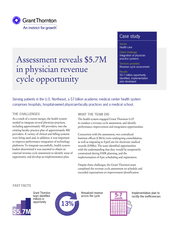To smooth the transition to the cloud, consider the finance and accounting implications – December 9, 2014
Grant Thornton
Description
To smooth the transition to the cloud, consider the finance and accounting implications
Whenever a new technology such as the cloud
emerges, companies and department managers
sometimes rush to adopt it without fully
understanding all of the ways it can affect the
organization. In moving to the cloud, companies
shouldn’t overlook the finance and accounting
implications, which influence efforts from risk
management and security to regulatory compliance.
Companies can reap the full benefits of an enterprisewide cloud deployment by taking the necessary time
and resources to understand the impact of cloud
solutions, conduct due diligence on providers, and
develop a framework to review security, compliance,
and internal processes on a regular basis.
Contact
Kevin Surovcik
Managing Director
Business Advisory Services
Grant Thornton LLP
T +1 215 814 4040
E kevin.surovcik@us.gt.com
grantthornton.com/silverlining
Content in this publication is not intended to answer specific questions or suggest suitability of action in a
particular case. For additional information about the issues discussed, consult a Grant Thornton LLP client
service partner or another qualified professional.
Connect with us
grantthornton.com
@grantthorntonus
linkd.in/grantthorntonus
“Grant Thornton” refers to Grant Thornton LLP, the U.S. member firm of Grant Thornton International Ltd (GTIL).
GTIL and the member firms are not a worldwide partnership. Services are delivered by the member firms. GTIL and its member firms are not agents of, and do not obligate, one another and are not liable for one another’s acts or omissions.
Please see grantthornton.com for further details. © 2014 Grant Thornton LLP  |  All rights reserved  |  U.S. member firm of Grant Thornton International Ltd .
GTIL and the member firms are not a worldwide partnership. Services are delivered by the member firms. GTIL and its member firms are not agents of, and do not obligate, one another and are not liable for one another’s acts or omissions.
Please see grantthornton.com for further details. © 2014 Grant Thornton LLP  |  All rights reserved  |  U.S. member firm of Grant Thornton International Ltd .









